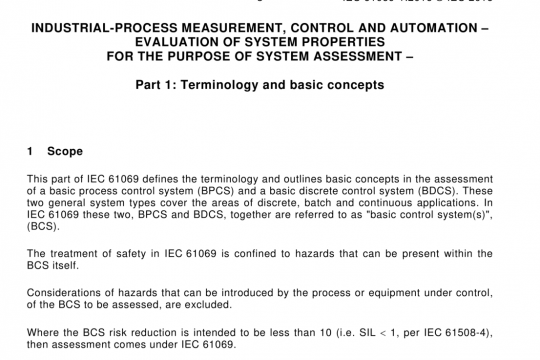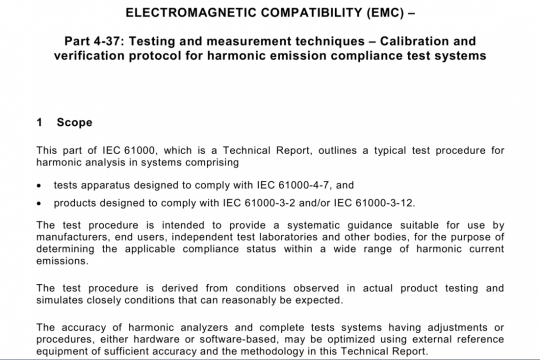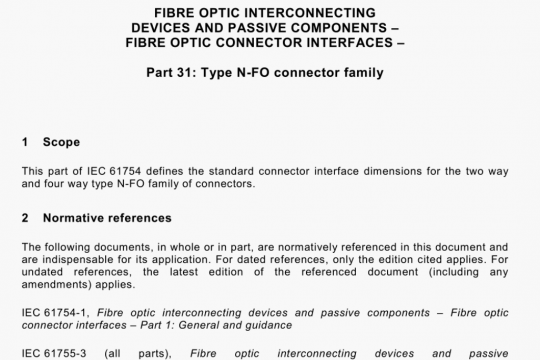IEC 62812 pdf free download
IEC 62812 pdf free download.Low resistance measurements – Methods and guidance.
The raised temperature on the unknown resistor due to self-heating not only affects the specimen, but also spreads the heat to the test assembly or mounting and affects those parts of the measurement circuit as well. Therefore, the raised temperature will be root cause of the variation of resistance with temperature, as discussed in 4.4, and of the thermoelectric e.m.f., as discussed in 4.5.
Self-heating is decreased by reducing the measuring current ‘M as much as possible while still providing the required voltage for a measurement with the desired accuracy. However, setting the measuring current is not a common feature with resistance meters. Other options to reduce the self-heating are to activate the measuring current for a short period only, as discussed in Clause 5, and of course to enhance the heat flow from the specimen and the test fixture.
4.4 Variation of resistance with temperature
One of the reference conditions prescribed in IEC 60115-1 for measuring the resistance is the reference temperature of 20 °C. For practical reasons, however, most tests and measurements are permitted to be executed under standard atmospheric conditions for testing as defined in IEC 60068-1, which includes a permissible range for the ambient temperature from 15 °C to 35 °C.
If measured with sufficient accuracy, a resistor measured at 15 °C or at 35 °C will not show the same resistance as when measured at 20 °C. In fact, there is a variation of resistance with temperature for almost every type of resistor, which typically does not follow a linear relationship. The slope and the amount of variation depend substantially on the technology and manufacturing of the resistor and in some cases also on the actual resistance.
Thermoelectric e.m.f. is superimposed upon the voltage generated on the unknown resistor by the sourced current, see Figure 7, and, therefore, can seriously affect the accuracy of a resistance measurement. Less obvious is that the distribution of currents in a node will also be affected if thermoelectric e.m.f. affects only one of the branches.
This issue of thermoelectric e.m.f. may be of static or of dynamic nature, depending on whether the temperature on the specimen and on the assembly or fixture has reached the steady state or not. Clause 5 discusses methods with a potential of eliminating the influence of a resulting thermal e.m.f. from the resistance measurement result.
4.6 Peltier effect
Another cause for a temperature difference, the Peltier effect, will remain unavoidable, even if the symmetrical heat flow proposed in 4.5 would be able to balance the internal sources of thermoelectric e.m.f. The Peltier effect is creating a temperature difference when a d.c. current is passed through the joint of two different materials. Hence, the variety of materials sequentially joined together in a resistor is likely to result in a sequence of temperature differences when such a resistor is subjected to a d.c. current, for example for measuring its resistance.
The heat generated by the Peltier effect is proportional to the d.c. current and the thermoelectric e.m.f. of the joined pair of materials. The temperature difference rises exponentially with a time constant to a terminal value, which are both determined by the design of the resistor and by the ability of the test fixture to dissipate heat to the environment. The resulting temperature difference is reversed when the d.c. current is reversed.
EXAMPLE 1 A 100 pC) resistor, manufactured by welding copper terminations to each side of a strip of CuNi44 resistive alloy, is measured in a suitable fixture with a current of 300 A in order to achieve a measurable voltage drop of 30 mV. The measuring current by means of the Peltier effect generates heat on the material joints, which have been observed to result in a temperature difference of 30 K after being loaded for 3 mm.IEC 62812 pdf download.




